The Supreme Court on Wednesday heard oral arguments in a case to ultimately decide whether to reinstate the Boston Marathon Bomber’s death sentence — a verdict rendered in district court but overturned in the U.S. Court of Appeals for the First Circuit.
The case surrounds the 2013 Boston Marathon Bombing perpetrated by the defendant, now-28-year-old Dzhokhar Tsarnaev, and his brother Tamerlan, who is dead. Both Tsarnaev and his brother, radicalized Islamic extremists, set off pressure cooker bombs near the finish line of the annual Boston Marathon in Boston, Massachusetts. Three people were killed, including an 8-year-old boy, and more than 260 people were wounded. The pair later killed an officer before Tamerlan was ultimately killed in a shootout with police.
The Court heard oral arguments from the government and Tsarnaev’s lawyer, with the main points of contention being whether the jury was properly vetted for biases and whether the district judge abused his discretion by excluding evidence from the Waltham murders in the case.
The Waltham murders, which to this day are unsolved, were the biggest point of debate during the hearing.
In 2019, a heavily redacted federal affidavit was unsealed during Tsarnaev’s appeal of his death sentence, revealing details of 2011 murders allegedly involving his brother Tamerlan and his friend Ibragim Todashev.
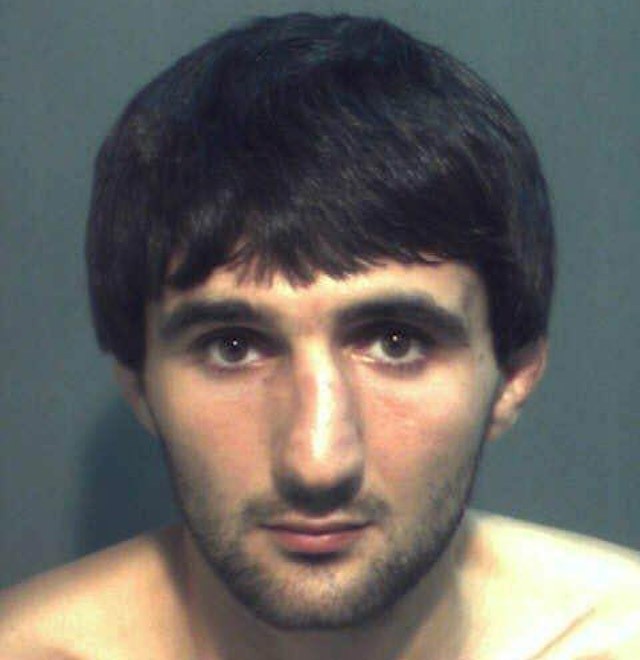
In this booking photo provided by the Orange County Sheriff’s Office, Ibragim Todashev poses for his mug shot after being arrested for aggravated battery, May 4, 2013, in Orlando, Florida. (Orange County Sheriff’s Office via Getty Images)
Todashev, who was reportedly shot multiple times by the FBI literally during a 2013 interview, confessed that he and Tamerlan participated in the “Waltham murders,” and both men “took several thousand dollars from the residence and split the money,” according to the Boston Herald.
On September 11, 2011, the 10-year anniversary of the 9/11 Terror Attacks, the men allegedly bound, beat, and slit the throats of Raphael Teken, 37, Erik Weissman, 31, and Brendan Mess, 25. They also reportedly left the men covered in marijuana and attempted to scrub the crime scene of fingerprints.
The district court judge ultimately excluded evidence related to the Waltham murders while deciding if Tsarnaev should receive the death penalty, saying the evidence was unreliable and would ultimately throw Tsarnaev’s case off-topic.
The oral argument, a procedure which typically lasts 1 hour, 30 minutes for each side, went 40 minutes longer than usual, as judges asked both the government and the defendant’s lawyer intricate questions concerning mitigating evidence, the Eighth Amendment of the U.S. Constitution, the Federal Death Penalty Act, and reliability of evidence.
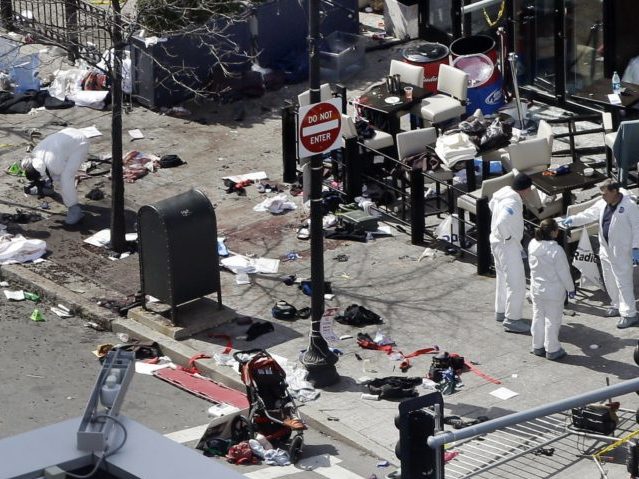
In this April 16, 2013, file photo, investigators examine the scene of the second bombing outside the Forum Restaurant on Boylston Street near the finish line of the 2013 Boston Marathon, a day after two blasts killed three and injured more than 260 people. (AP Photo/Elise Amendola, File)
Hearing Highlights
Overall, the main argument was whether the district judge was correct in excluding evidence from the Waltham murders or whether he abused his discretion in doing so.
Tsarnaev’s lawyer argued that the district court violated the U.S. Constitution’s Eighth Amendment and the Federal Death Penalty Act (FDPA) by excluding “reliable evidence” that “went to the heart of Dzhokhar’s mitigation case.”
Tsarnaev’s lawyer Ginger Anders contended that the Waltham murders show how Tsarnaev’s older brother had a propensity for violence and ultimately ended up playing a role in radicalizing Tsarnaev and manipulating him into participating in the Boston bombings. She argued, using corroborating evidence, that the Waltham murders were Tamerlan’s first act of violent jihad and that he led the murders. She also alleged Tamerlan was the main planner of the Boston bombings.
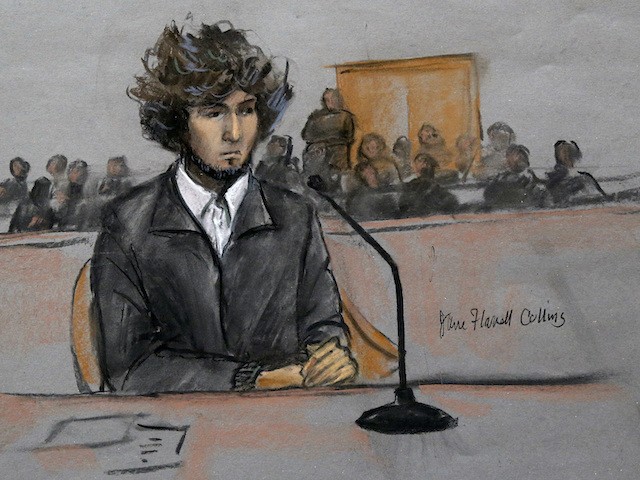
In this December 18, 2014, courtroom sketch, Dzhokhar Tsarnaev sits in federal court in Boston for a final hearing before his trial begins in January. (Jane Flavell Collins via AP)
The jury, however, never heard the indoctrination theory as a result of the district judge’s order to exclude the evidence. The theory was the defense’s only argument for foregoing the death penalty and asking for Tsarnaev to be sentenced to life in prison instead.
The district judge argued it was impossible to prove, based off the evidence, whether Tamerlan indeed was the main leader in the Waltham murders, making the basis for the defense’s theory unreliable. Anders argued that the verdict could have been changed if jurors were able to hear the evidence for themselves and make a decision.
In contrast, the U.S. waged that the murders are an entirely different crime with seemingly different motives, and both parties reportedly involved are dead. To have battled over the details of the separate crimes in court “was exceedingly unlikely to be productive” when discussing Tsarnaev’s role in the Boston bombings, the briefing argues.
U.S. Deputy Solicitor General Eric Feigin argued:
I think, if this jury heard that Respondent was aware or thought that Tamerlan had committed a murderous act of jihad, it would have expected him to be horrified, not to view that as an affirmative reason to not only follow him in jihad but to take an even more murderous act by planting a bomb at the Boston Marathon.
The Supreme Court justices heavily contemplated the implications of excluding evidence of the unsolved 2011 murders. Perhaps the most tense exchange during the hearing occurred between Justice Elena Kagan and Justice Brett Kavanaugh after Kagan asked the government to engage in a hypothetical argument.
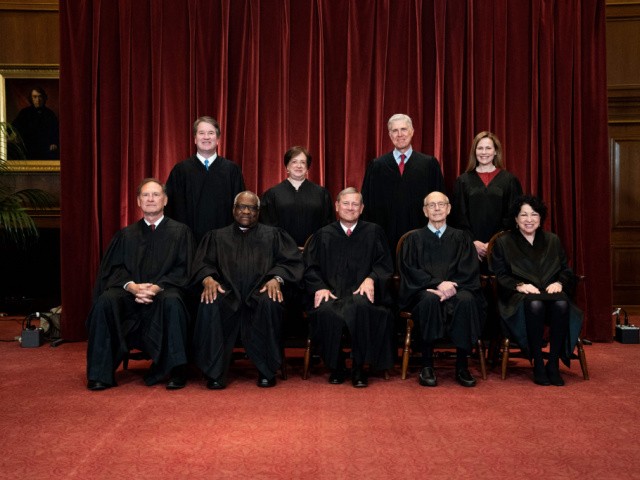
Seated from left: Associate Justice Samuel Alito, Associate Justice Clarence Thomas, Chief Justice John Roberts, Associate Justice Stephen Breyer, and Associate Justice Sonia Sotomayor. Standing from left: Associate Justice Brett Kavanaugh, Associate Justice Elena Kagan, Associate Justice Neil Gorsuch, and Associate Justice Amy Coney Barrett pose during a group photo of the Justices at the Supreme Court in Washington, DC on April 23, 2021. (Erin Schaff /Pool/AFP via Getty Images)
“…Assume for me that the evidence was very strong that Tamerlan participated in and indeed had a leading role in the Waltham murders, all right? So assume that the evidence is strong with respect to that,” Kagan said. “In that case, would the court have committed reversible error by refusing to participate — to admit that evidence?”
Feigin said that in Kagan’s pretend scenario, the government should have admitted the evidence.
“If the defendant was aware of it and there was strong evidence of it, I think the district court should have let it in. Neither of those was true here,” he argued.
Kagan, who is typically more liberal in her opinions, further questioned whether it was the district judge’s place to exclude the evidence or if it should have been presented for the jury to decide.
“… It’s the job of the jury, isn’t it, to decide on the reliability of the evidence, to decide whether it’s strong evidence or weak evidence that Tamerlan, in fact, played a leading role in those other gruesome murders?” she posited, before ultimately telling Feigin that the entirety of the government’s cases rests on the “notion that this evidence just wasn’t strong enough” to confirm Tamerlan as the leader in the murders.
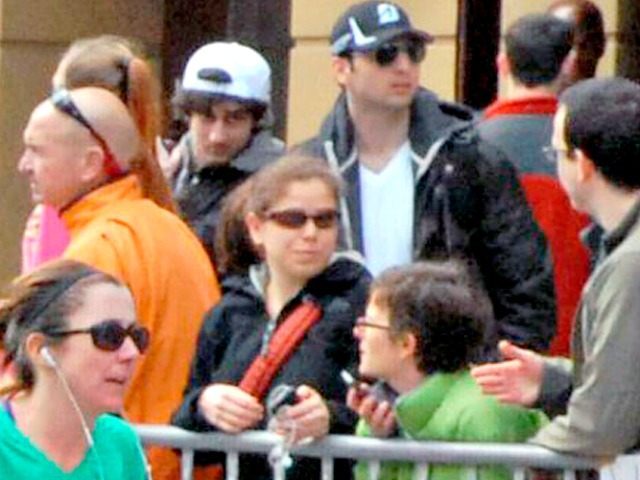
This Monday, April 15, 2013, file photo provided by Bob Leonard shows second from right, Tamerlan Tsarnaev, who was dubbed Suspect No. 1, and third from right, Dzhokhar A. Tsarnaev, who was dubbed Suspect No. 2 in the Boston Marathon bombings by law enforcement. (AP Photo/Bob Leonard, File)
Justice Kavanaugh cast doubt on Kagan’s hypothetical line of questioning and brought attention to the district court judge’s argument for excluding the evidence.
“Mr. Feigin, at the beginning of this entire line of questioning, you were asked to assume away something, and I’m confused because you were asked to assume away what I think was the district court’s reasoning here,” Kavanaugh said.
“Because the district court said, and I’m quoting, there was ‘insufficient evidence to describe what participation Tamerlan may have had in those events,'” he continued. “And ‘it is as plausible that Todashev was the bad guy and Tamerlan was the minor actor. There’s just no way of telling who played what role if they played roles.”
Kagan jumped in to defend her request for a hypothetical discussion related to the evidence in the Waltham murders, saying the premise “was assumed away because that’s the role of the jury.”

From left, Supreme Court Associate Justices Brett Kavanaugh, Neil Gorsuch, and Elena Kagan speak together in the audience before President Donald Trump arrives for a Medal of Freedom ceremony in the East Room of the White House in Washington, November 16, 2018. (AP Photo/Andrew Harnik)
“Well, I think it’s important to discuss the district court’s reasoning. And the district court said, we don’t know what happened,” Kavanaugh rebutted.
Justice Stephen Breyer bounced off Justice Kagan’s point, asking Feigin why, if the evidence was so unreliable, did the government use Todashev’s confession as grounds to search a car during the investigation.
“Now, if the government thinks it stands up enough to show probable cause at least, isn’t it enough to get into a death case?” Breyer asked. Notably, the standard for admitting evidence in death penalty cases is lower in order to adhere to the Eighth Amendment and to weigh mitigating circumstances.
More conservative Justice Neil Gorsuch contemplated the district judge’s thought process in excluding the evidence, as did Justice Kavanaugh.
“…On the Waltham murders, we have to review the district court’s decision, maybe for abuse of discretion, maybe for something else,” Gorsuch said. “And he had to weigh, though, in his mind, on the one hand, the relevance and, on the other hand, the potential for confusion under the statute.”
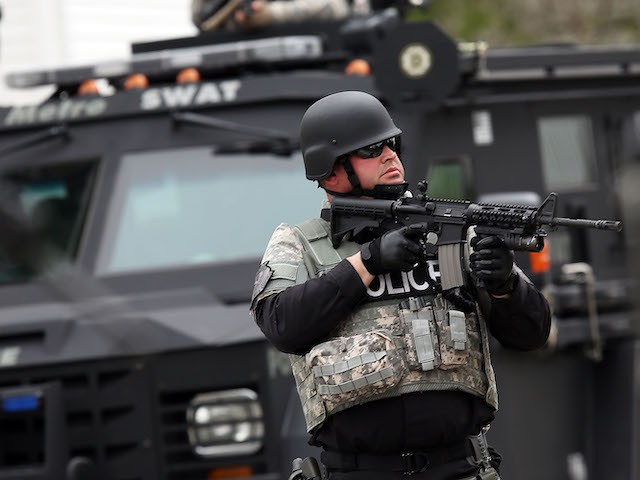
Members of a police SWAT team search through a neighborhood in Watertown as they search for 19-year-old bombing suspect Dzhokhar A. Tsarnaev on April 19, 2013, in Watertown, Massachusetts. (Spencer Platt/Getty Images)
“The district court here was presented with this theory, and the district court said, we don’t know what happened. There’s been insufficient evidence of who did what,” Kavanaugh said:
And, therefore, the theory that Tamerlan was the lead player in that is entirely — well, is unreliable because we don’t know, and Todashev had all the motive in the world to point the finger at the dead guy to say that he was the ringleader of slitting the throats of the three drug dealers, right?
Feigin replied in agreement, and then proceeded to argue that district has a “very important gatekeeping role here” to keep out “inherently unreliable evidence.”
Justice Amy Coney Barrett did question Feigin on the government’s purpose in wishing to reinstate the death penalty for Tsarnaev. For context, President Joe Biden is the first sitting U.S. president to oppose capital punishment.
“Mr. Feigin, I’m wondering what the government’s end game is here? So the government has declared a moratorium on executions, but you’re here defending his death sentences,” she said. “And if you win, presumably, that means that he is relegated to living under the threat of a death sentence that the government doesn’t plan to carry out. So I’m just having trouble following the point.”
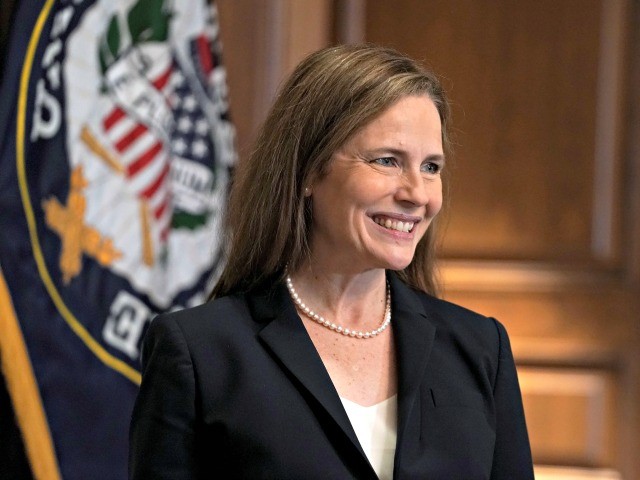
Amy Coney Barrett participates in a photo op in the Mansfield Room of the U.S. Capitol on October 21, 2020, in Washington, DC. (Greg Nash/Pool/Getty Images)
Feigin replied by loosely arguing that the government wants the wishes of the original jurors in the case honored, meaning the verdict should be fulfilled. He said in part:
What we are asking here is that the sound judgment of 12 of Respondent’s peers that he warrants capital punishment for his personal acts in murdering and maiming scores of innocents, and along with his brother, hundreds of innocents at the finish line of the Boston Marathon should be respected.
Chief Justice John Roberts pushed back on Tsarnaev’s lawyer after she supplied examples of corroborating evidence that suggested the Waltham murders were a blatant act of jihad that swayed Tsarnaev to become radicalized.
“Well, it would change the — assuming it would change the terms of the debate, it would focus debate on something that the district court determined really just couldn’t be resolved. There were no witnesses available. They were both dead,” Roberts said. “And he concluded that that would require — I don’t know if he used the term or not, but a mini-trial, certainly a detour into something that, at the end of the day, there was no basis for resolving.”
“It isn’t a question of, you know, who do you believe. It’s — they’re both dead, and — and they’re not there. And — and you — the determination is whether that — whether that was an abuse of discretion,” he continued.
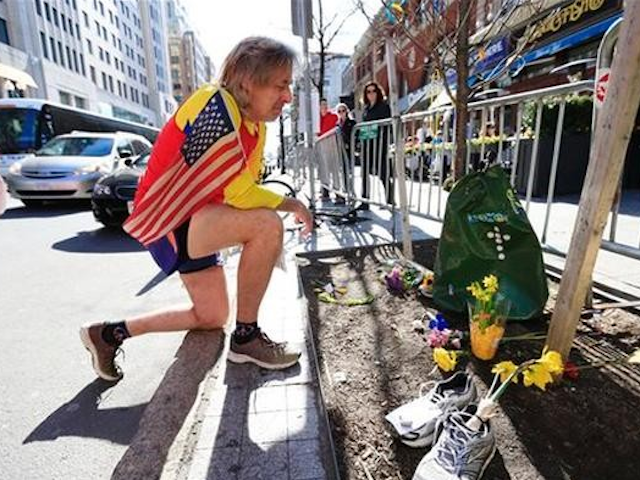
Ron McCracken of Dallas pays his respects at a makeshift memorial honoring the victims of the 2013 Boston Marathon bombings ahead of Monday’s 118th Boston Marathon, April 20, 2014, in Boston. (AP Photo/Matt Rourke)
Anders contended in the response that the district court committed a legal error in making that conclusion.
“And so I think the jury would have evaluated this evidence the way it would evaluate any hearsay evidence. It would put the statement next to the corroborating evidence, and it would decide what it thought,” she argued.
Feigin had the final word at the end of the hearing, in which he posited that regardless of whether evidence pertaining to the Waltham murders had been admitted, the jury vied for the death penalty in response to video evidence of Tsarnaev willingly placing a bomb behind a group of children at the Boston Marathon and walking away.
“That’s all the evidence that the jury heard that was admissible evidence that came in in this case,” he said. “And the jury’s nuanced verdict in this case was based on that evidence, not anything about pretrial publicity or anything about Waltham.”
The Supreme Court will hand down its decision by July, ultimately deciding the fate of the Boston Marathon Bomber.
The case is United States v. Tsarnaev, No. 20-443 in the Supreme Court of the United States.
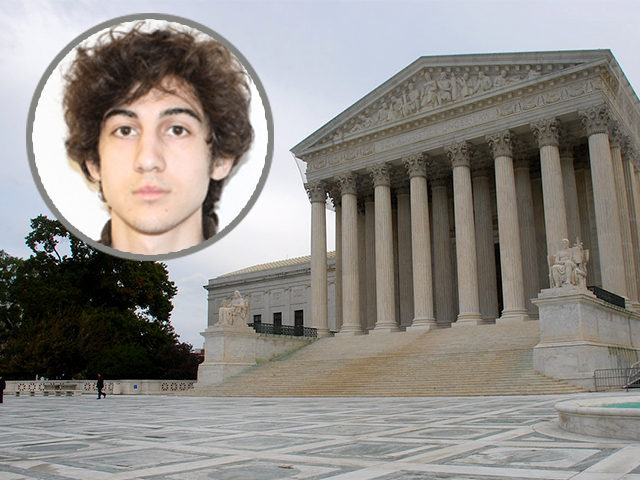
COMMENTS
Please let us know if you're having issues with commenting.